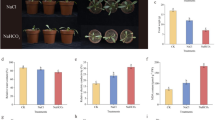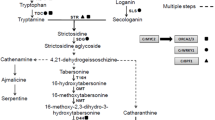Abstract
When the leaf segments of rice (Oryza sativa L.) plants were subjected to chilling in the moderate light, zeaxanthin (Zx) formation was faster in a chilling-tolerant Dongjin-byeo (DJ) than in a chilling-sensitive IR841. Although the rate of Zx formation was accelerated by the treatment of 5 mM salicylaldoxime, an inhibitor of Zx epoxidase (ZE), there was almost no changes in DJ. A similar result was observed when leaf segments were treated with 50 mM sodium fluoride, a potent inhibitor of chloroplast phosphatase. The slow Zx epoxidation in IR841 during light-chilling was confirmed in leaf segments treated with 10 mM dithiothreitol, an inhibitor of violaxanthin de-epoxidase (VDE). However, the differences between the two cultivars were not observed at 25oC. These results suggest that compared with IR841 the higher rate of Zx formation in DJ is not due to the higher VDE activity in DJ but is due to more rapid down-regulation of ZE in DJ, possibly by its phosphorylation. Compared with DJ, IR841 accumulated more superoxide with PSI inactivation during light-chilling, which eliminates the possibility of increased ZE down-regulation in DJ leaves by photo-oxidation. In vitro study with alkaline phosphatase supports the idea of down-regulation of ZE by phosphorylation under light-chilling condition. We propose that this reversible down-regulation of Zx epoxidation possibly by the phosphorylation of ZE is an important regulation mechanism of violaxanthin cycle that confers chilling tolerance of a rice cultivar under chilling stress in the light with moderate intensities.
Similar content being viewed by others
References
Adams WWIII, Demmig-Adams B, Rosenstiel TN, Brightwell AK, Ebbert V (2002) Photosynthesis and photoprotection in overwintering plants. Plant Biol 4:545–557
Aro E-M, McCaffery S, Anderson JM (1993) Photoinhibition and D1 protein degradation in peas acclimated to different growth irradiances. Plant Physiol 103:835–843
Arnoux P, Morosinotto T, Saga G, Bassi R, Pignol D (2009) A structural basis for the pH-dependent xanthophyll cycle in Arabidopsis thaliana. Plant Cell 21:2036–2044
Arvidsson P-O, Carlsson M, Stefánsson H, Albertsson P-A, Akerlund H-E (1997) Violaxanthin accessibility and temperature dependency for de-epoxidation in spinach thylakoid membranes. Photosynth Res 52:39–48
Asada K (1999) The water-water cycle in chloroplasts: scavenging of active oxygens and dissipation of excess photons. Annu Rev Plant Physiol Plant Mol Biol 50:601–639
Bilger W, Björkman O (1991) Temperature dependence of violaxanthin de-epoxidation and non-photochemical fluorescence quenching in intact leaves of Gossypium hirsutum L. and Malva parviflora L. Planta 184:226–234
Bratt CE, Arvidsson P-O, Carlsson M, Åkerlund H-E (1995) Regulation of violaxanthin de-epoxidase activity by pH and ascorbate concentration. Photosynth Res 45:169–175
Carlberg I, Bingsmark S, Vennigerholz F, Larsson UK, Anderson Bexcitation energy in leaves in 2% (1992) Low temperature effects on thylakoid protein phosphorylation and membrane dynamics. Biochim Biophys Acta 1099:111–117
Chen Z, Gallie DR (2012) Violaxanthin de-epoxidase is rate-limiting for non-photochemical quenching under subsaturating light or during chilling in arabidopsis. Plant Physiol Biochem 58:66–82
Demmig B, Winter K, Krüger A, Czygan F-C (1987) Photoinhibition and zeaxanthin formation in intact leaves: A possible role of the xanthophyll cycle in the dissipation of excess light energy. Plant Physiol 84:218–224
Demmig-Adams B, Winter K, Krüger A, Czygen F-C (1989) Zeaxanthin and the induction and relaxation kinetics of the dissipation of excess excitation energy in leaves in 2% O2, 0% CO2. Plant Physiol 90:887–893
Demmig-Adams B, Adams WWIII, Barker DH, Logan BA, Bowling DR, Verhoeven AS (1996) Using chlorophyll fluorescence to assess the fraction of absorbed light allocated to thermal dissipation of excess excitation. Physiol Plant 98:253–264
Eskling M, Arvidsson P-O, Åkerlund H-E (1997) The xanthophyll cycle, its regulation and components. Physiol Plant 100:806–816
Gilmore AM, Bjökman O (1994a) Adenine nucleotides and the xanthophyll cycle in leaves. I. Effects of CO2- and temperaturelimited photosynthesis on adenylate energy charge and violaxanthin de-epoxidation. Planta 192:526–536
Gilmore AM, Bjökman O (1994b) Adenine nucleotides and the xanthophyll cycle in leaves. II. Comparison of the effects of CO2- and temperature-limited photosynthesis on photosystem II fluorescence quenching, the adenylate energy charge and violaxanthin de-epoxidation in cotton. Planta 192:537–544
Gilmore AM, Ball MC (2000) Protection and storage of chlorophyll in overwintering evergreens. Proc Natl Acad Sci USA 97:11098–11101
Gruszecki WI, Grudzinski W, Banaszek-Glos A, Matula M, Kernen P, Krupa Z, Sielewiesiuk J (1999) Xanthophyll pigments in lightharvesting complex II in monomolecular layers: localisation, energy transfer and orientation. Biochim Biophys Acta 1412:173–183
Gruszecki WI, Grudzinski W, Gospodarek M, Patyra M, Maksymiec W (2006) Xanthophyll-induced aggregation of LHCII as a switch between light-harvesting and energy dissipation systems. Biochim Biophys Acta 1757:1504–1511
Hager A, Holocher K (1994) Localization of the xanthophyll-cycle enzyme violaxanthin de-epoxidase within the thylakoid lumen and abolition of its mobility by a (light-dependent) pH decrease. Planta 192:581–589
Havaux M (1998) Carotenoids as membrane stabilizers in chloroplasts. Trends Plant Sci 3:147–151
Hwang HJ, Xu CC, Moon BY, Lee C-H (2003) Recovery from lowtemperature photoinhibition is related to dephosphorylation of phosphorylated CP29 rather than zeaxanthin epoxidation in rice leaves. J Plant Biol 46:122–129
Ivanov AG, Morgan RM, Gray GR, Velitchkova MY, Hunder NPA (1998) Temperature/light dependent development of selective resistance to photoinhibition of photosystem I. FEBS Lett 430:288–292
Jahns P (1995) The xanthophyll cycle in intermittent light-grown pea plants: possible functions of chlorophyll a/b-binding proteins. Plant Physiol 108:149–156
Jahns P, Latowski D, Strzalka K (2009) Mechanism and regulation of the violaxanthin cycle: The role of antenna proteins and membrane lipids. Biochim Biophys Acta 1787:3–14
Kim J-H, Hwang HJ, Park H-S, Lee CB, Kwon YM, Lee C-H (1997) Differences in the rate of dephosphorylation of thylakoid proteins during dark incubation after chilling in the light between two rice (Oryza sativa L.) varieties. Plant Sci 128:159–168
Kim J-H, Kim S-J, Cho SH, Chow WS, Lee C-H (2005) Photosystem I acceptor side limitation is a prerequisite for the reversible decrease in the maximum extent of P700 oxidation after shortterm chilling in the light in four plants species with different chilling sensitivities. Physiol Plant 123:100–107
Klughammer C and Schreiber U (1994) An improved method, using saturating light pulses, for the determination of photosystem I quantum yield via P700+-absorbance changes at 830 nm. Planta 192:261–268
Krause GH, Weis E (1991) Chlorophyll fluorescence and photosynthesis - the basics. Annu Rev Plant Physiol Plant Mol Biol 42:313–349
Mauro S, Dainese P, Lannoye R, Bassi R (1997) Cold-resistant and cold-sensitive maize differ in the phosphorylation of the photosystem II subunit, CP29. Plant Physiol 115:171–180
Neubauer C, Yamamoto HY (1994) Membrane barriers and mehlerperoxidase reaction limit the ascorbate available for violaxanthin de-epoxidase activity in intact chloroplasts. Photosynth Res 39:137–147
Öquist G, Huner NP (2003) Photosynthesis of overwintering evergreen plants. Annu Rev Plant Biol 54:329–355
Peter GF, Thornber JP (1991) Biochemical composition and organization of higher plant photosystem II light-harvesting pigment-proteins. J Biol Chem 266:16745–16754
Pfündel E, Bilger W (1994) Regulation and possible function of the violaxanthin cycle. Photosynth Res 42:89–109
Pfündel E, Dilley R (1993) The pH dependence of violaxanthin deepoxidation in isolated pea chloroplasts. Plant Physiol 101:65–71
Reinhold C, Niczyporuk S, Beran KC, Jahns P (2008) Short-term down-regulation of zeaxanthin epoxidation in Arabidopsis thaliana in response to photo-oxidative stress conditions. Biochim Biophys Acta 1777:462–469
Schaller S, Latowski D, Jemioła-Rzemińska M, Wilhelm C, Strzałka K, Goss R (2010) The main thylakoid membrane lipid monogalactosyldiacylglycerol (MGDG) promotes the de-epoxidation of violaxanthin associated with the light-harvesting complex of photosystem II (LHCII). Biochim Biophys Acta 1797:414–424
Siefermann D, Yamamoto HY (1974) Light-induced de-epoxidation of violaxanthin in lettuce chloroplasts. III. Reaction kinetics and effect of light intensity on de-epoxidase activity and substrate availability. Biochim Biophys Acta 357:144–150
Somersalo S, Krause GH (1989) Photoinhibition at chilling temperature: fluorescence characteristics of unhardened and cold-acclimated spinach leaves. Planta 177:409–416
Sonoike K (2006) Photoinhibition and protection of photosystem I. In: John HG (ed) Photosystem I: The Light-Driven Plastocyanin: Ferredoxin Oxidireductase, Springer, Dordrecht, pp 657–668
Thayer SS, Björkman O (1990) Leaf xanthophylls content and composition in sun and shade determined by HPLC. Photosynth Res 23:331–343
Xu CC, Jeon YA, Lee C-H (1999a) Relative contributions of photochemical and non-photochemical routes to excitation energy dissipation in rice and barley illuminated at a chilling temperature. Physiol Plant 107:447–453
Xu CC, Jeon YA, Hwang HJ, Lee C-H (1999b) Suppression of zeaxanthin epoxidation by chloroplast phosphatase inhibitors in rice leaves. Plant Sci 146:27–34
Yamamoto HY, Chang JL, Aihara MS (1967) Light-induced interconversion of violaxanthin and zeaxanthin in New Zealand spinachleaf segments. Biochim Biophys Acta 141:342–347
Yamamoto HY, Bassi R (1996) Carotenoids: localization and function. In: Ort DR, Yocum CF (eds) Oxygenic Photosynthesis: the Light Reaction. Kluwer Academic Publishers, Dordrecht, pp 539–563
Yamamoto HY, Kamite L (1972) The effects of dithiothreitol on violaxanthin de-epoxidation and absorbance changes in the 500-nm region. Biochim Biophys Acta 267:538–543
Zulfugarov IS, Tovuu A, Eu Y-J, Dogsom B, Poudyal RS, Nath K, Hall M, Banerjee M, Yoon UC, Moon Y-H, An G, Jansson S, Lee C-H (2014a) Production of superoxide from Photosystem II in a rice (Oryza sativa L.) mutant lacking PsbS. BMC Plant Biol 14:242
Zulfugarov IS, Tovuu A, Lee C-H. (2014b) Acceleration of cyclic electron flow in rice plants (Oryza sativa L.) deficient in the PsbS protein of Photosystem II. Plant Physiol Biochem 84:233
Author information
Authors and Affiliations
Corresponding author
Electronic supplementary material
Rights and permissions
About this article
Cite this article
Kim, HS., Hoang, M.H., Jeon, Y.A. et al. Differential down-regulation of zeaxanthin epoxidation in two rice (Oryza sativa L.) cultivars with different chilling sensitivities. J. Plant Biol. 60, 413–422 (2017). https://doi.org/10.1007/s12374-016-0483-8
Received:
Accepted:
Published:
Issue Date:
DOI: https://doi.org/10.1007/s12374-016-0483-8




